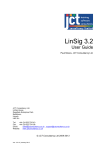Download Users Manual
Transcript
STANDER CAT 1 ™ Use and Maintenance Instruction R ! CAUTION! Manufacturer takes responsibility for proper usage of the device only when the product was purchased from qualified Akces-Med employee or at specialized medical store. Medical product first class according to the Regulation 93/42/EWG of European Parliament and Council regarding medical products. For this product the producer issued relevant declaration of conformity. Producer's identification number in the Registration Department of Healing Products, Medical Products and Biocide Products: PL/CA01 04088/W QUALITY MANAGEMENT SYSTEM 13485 Akces-Med Sp. z o.o. Company introduced quality management system ISO 13485 regarding production, sales and service. The system is certified by Det Norske Veritas.. CONTENT: 1. The purpose of the manual.........……….........................................................................5 2. Indications for use Cat 1 Stander..............................................................................5 3. General characteristics of Cat 1 Stander...........................................................................6 3.1 Standard equipment .............................................................................................6 3.2 Additional equipment ......................................................................................6 4. Weight and measurements.............................................................................................7 5. Size table.........................................................................................................................7 6. Detailed description how to use Cat 1 Stander ........………….......................................8 6.1 Adjustment of the height of trunk stabilization and pelottes............................8 6.2 Adjustment of the pelottes....................................................................9 6.3 Adjustment of the stabilizing belts....................... …………………….10 6.4 Adjustment of thigh abduction wedge ...........................................11 6.5 Adjustment of 6.6 Adjustment foot stabilizer......... …… ........ ………………………....11 of tilt angle .…….......................................................12 6.7 Adjustment of table and pillow assembly.........................................................13 7. How to assemble an optional equipment……..................…….......................................14 7.1 Head supporting belt........................................................................................14 7.2 Table for manual therapy.....................................................................................14 7.3 Presser foot with adjustment……......….........…………..........………………………….14 8. The use of Cat 1 Stander ..............................................................................................15 8.1 Preparation of the patient.....................................................................................15 8.2 Preparation of device before each use..................................................................16 8.3 Upright position...................................................................................................17 9. Safety rules................................................................................................19 10. Maintenance and cleaning..................................................................................22 INTRODUCTION Stander CAT 1 was created for little patients with disorders which hinder or make it impossible for them to adopt an upright position single-handedly ( with trunk or lower limbs paresis and tetraparesis of different origin). A wide range of adjustment in this device enables children with different dysfunctions of locomotor system to adopt an upright position. This device is user-friendly because of colourful upholstery which stimulates the sense of sight and touch. Moreover, the manufacturer used wood , a natural material, whose pattern and colouring are well-known for children. Please read the instruction carefully. You will find the information about our product and you will find out how to use it effectively and safely. If you have any questions or comments, please contact the medical consultant of our company (ph. 0 508-382-509) or contact directly with our office (ph. 0-17 864 04 70) . Thanks for confidence and buying our product. The manual contains basic information which is essential for correct using of this device such as: the preparation of standing frame for work, guarantee conditions and the way of maintenance as well as cleaning. This handbook ought to be kept in an accessible place. The manual is designed for people who take care of disabled children as well as for doctors and physiotherapist operating that device. Please, remember that complying with guidelines included in this manual will make it possible to use this device safely. Furthermore, it will prolong its durability and aesthetic. ! 4 CAUTION! Before using the product, user is obliged to familiarize himself/herself with user manual. Remember that complying with guidelines is highly important. It assures safety and extends durability as well as aesthetics of the device. R 1. The purpose of the manual The present manual contains basic information which is essential for correct using of the stander Cat 1 . Thanks to this manual we will get to know with guarantee conditions and we will find out how to prepare, clean and maintain the device. This handbook ought to be kept in an accessible place. The manual is designed for people who take care of disabled children as well as for doctors and physiotherapist operating that device. ! CAUTION! The user is obliged to get to know with the content of this manual before the use of the stander Cat 1. Please, remember that complying with guidelines included in this manual will make it possible to use this device safely. Furthermore, it will prolong its durability and aesthetic. 2. Indications for use Cat 1 Stander CAT 1 is created for upright standing in a front position for children who weigh up to 25kg and have disorders which prevent them from standing and walking single-handedly. Furthermore, adopting an upright position is a key element which prepares a child for learning to walk. An upright position is a first step to further process of streamlining. What's more, it has a significant influence on stimulation of psychomotor development. It stimulates the systems such as: skeletal, muscular, vascular, respiratory, alimentary and excretory. The possibility of upright position, for a child who cannot move as a result of disease or an accident, has an enormous as well as positive influence on patient's mental state. Thanks to a suitable use of wedges, pelottes and belts a flabby or spastic body can have a correct stabilization. Moreover, it also protects from constraints, contractures and osteoarticular deformities. Standing frame is designed for use in a confined space. R 5 3. General characteristics of Cat 1 Stander 3.1. Standard equipment 1. Frame with castors equipped with brakes 2. Foot stabilizer 3. Pelvic pelottes with belt stabilizing hips 4. Chest pelottes with belt stabilizing chest. 5. Thigh abduction wedge. 6. Tray 7. Soft cover for tray 8. Gas spring 7 4 3 6 5 8 1 2 3.2. Additional equipment KT_001 Tray for manual therapy KT_002 Head supporting belt KT_005 Tray with bowl 6 R KT_003 3D foot adjustment Hip width [cm] 13,5 57 - 20 25 25 78 18 90 User weight (max) Product weight Product height Product width Product length CAT 1 Weight [kg] Upright position angle [°] Foot lenght [cm] Foot rest to tray [cm] Chest width [cm] Min CAT 1 13,5 Max 4. Weight and measurements Product dimensions [cm] 25 20 62 56 86 5. Size table R 7 6. Detailed description how to use Cat 1 Stander 6.1 Adjustment of the height of trunk stabilization and pelottes In order to adjust the height of trunk stabilization it is necessary to: ź loosen 4 fastening knobs, ź adjust the height according to the measurements of the patient which were taken with the standing frame, ź when we obtain the suitable height we should screw knobs. Next, it is essential to adjust pelvic pelottes: ź loosen two blocking knobs, ź adjust the suitable position of pelottes, move pelottes up or down, ź screw knobs. 8 R 6.2 Adjustment of the pelottes In order to adjust pelottes it is necessary to: ź loosen knobs which fasten chest pelottes (1) pelvic pelottes (2), ź adjust pelottes according to measurement of the patient, ź screw knobs. 2 1 R 9 6.3 Adjustment of the stabilizing belts In order to adjust the stabilizing belts it is necessary to : ź unfasten snap clips from a supporting belt ź tailor the length of the main belt to the patient with the use of Velcro situated on the pelottes, ź after obtaining the correct length of the main belt it is necessary to use snap clip as well as adjust the length of the supporting belts. Pull the belt in order to check if: ź the clips do not unfasten because of pressure force, ź the clips do not move over the belt because of incorrect assembly. 10 R 6.4 Adjustment of thigh abduction wedge In order to adjust the wedge it is necessary to: ź loosen fastening knob, ź move the wedge up or down till we obtain the correct alignment, ź after obtaining the correct alignment, we should screw the knob. 6.5 Adjustment of foot stabilizer In order to adjust the foot stabilizer it is necessary to: ź loose set screw knob ź move presser foot till we obtain an appropriate position, ź after obtaining the correct position of presser foot, we should screw R 11 6.6 Adjustment of tilt angle In order to obtain desired tilt angle it is advisable to: ź move lever which protects a servo-motor, ź lower or lift trunk stabilizer in order to obtain a proper tilt angle ź after obtaining a proper tilt angle, we should protect a servo-motor by lowering a lever. 12 R 6.7 Adjustment of table and pillow assembly In order to adjust a table gradient it is necessary to: ź loose all set screw knobs ź lower or lift a table until we will obtain a proper angle, ź screw knobs. An angle should be adapted to : ź tilt angle of a standing frame ź the way in which children's hands are placed Hands should lie freely on the table, it makes it possible for a child to perform different manual actions. It is recommended to leave a pillow for children who: ź have uncontrolled pressure force from upper limbs towards a table, ź have problems with controlling limbs atheotosis. Pillow should be assembled by putting three belts into slots which are situated on the edge of a table. After we should fasten a pillow to the second side of a top by using Velcro. R 13 7. How to assemble an optional equipment 7.1 Head supporting belt In order to assemble head supporting belt it is necessary to: ź pull a bowl out of equipment, ź leave unsecured slot in a table which is designed for a child's head, ź loose set screw knobs in a table, ź place a table in order that it stabilizes head from the front, ź screw set screw knobs in a table, ź fasten head supporting belts and tailor their length to a child. 7.2 Table for manual therapy In order to assemble a table for manual therapy it is necessary to: ź put a therapeutic table on the standing frame table in order that its side edge would rest against a band. 7.3 Presser foot with adjustment In order to assemble presser foot with adjustment it is necessary to: ź dismantle standard presser foot, ź dismantle presser foot with adjustment in the same places 14 R 8. The use of Cat 1 Stander ! CAUTION! Stander CAT 1 has to be used with compliance to guidelines included in this user manual. Remember to use the product only with someone who is trained and knowledgeable. 8.1. Preparation of the patient Before using the product, it is essential to make sure that: · patient's outfit is light and comfortable sporty clothes are advisable, · shoes should be comfortable and, moreover, they should stabilize ankle, · due to hygienic reason and to avoid abrasion it is advisable for the patient to always wear clothes when using the device, skin must not be naked especially in places of regular contact with upholstery, · drains, bags, catheters etc. if applied, have to be secured to function properly and not to disturb during using the product, · if it is necessary for a patient to wear orthopedic supply (collar, corset, orthesis, shoes) if it is recommended by doctor. ! CAUTION! Outfit should protect patient's skin from direct contact with upholstery as well as other parts of equipment. ! CAUTION! Only doctor can make a decision concerning using any kind of orthopedic supply! R 15 8.2. Preparation of device before each use 1. Before use it is necessary to: ź unfold the device; ź place the device on even ground in a way that it is easy to reach standing frame and person who sits inside; remember to keep standing frame away from fire and high temperature ź make sure that all parts are serviceable, correctly mounted and stable ź check castors and brakes ź lock brakes 2. Adjust the device according to patient's measurements 3. Release actuator's lever so as to adjust trunk support 4. Unfasten chest and pelvic belt, footer belts so as to easily place the patient in the device. Equipment works correctly only when the device is adjusted according to patient's height as well as weight. Remember to take all these measurements into account while purchasing the product. Correct adjustment is the most important due to the fact that only then the product is safe. It is forbidden to force child to keep specific position because he/she will feel uncomfortable and it may lead to wrong posture. ! ! 16 CAUTION! First adjustment of standing frame can be performed only by someone who is traned. Further adjustment is performed by patient's relatives who had proper training concerning the usage as well as adjustment of this device. Remember that correct adjustment is essential due to the fact that the product is safe and, moreover, the rehabilitation process CAUTION! Remember to make sure that all belts and locking are correctly adjusted and fastened. Check also if fastenings from adjustable elements are firmly tightened. R 8.3. Upright position It is necessary to: 1. Prepare a place for upright standing. It is important to choose a room without any dangers (such as: strewn toys or other objects) 2. Move a standing frame closer to a place in which the patient is situated. 3. Block castors from a standing frame, wheel chair or other device in which the patient is sitting. 4. Move the patient and place him in a standing frame. We ought to make sure that all alignments are preserved. Implement corrections if necessary. 5. Fasten belts stabilizing chest, hips and foot. 6. Make sure that all belts and precautions were correctly adjusted and fastened. 7. When we stabilize the patient's body we should unblock the lever which protects a servo-motor. It is important to talk as well as have an eye contact with the patient during that action. After, we slowly place the patient in the direction of upright position. When we obtain a proper tilt angle, it is necessary to block the device by releasing the lever in order that a servo-motor will be blocked. CAUTION! The length of time for upright position process is different for each patient. It is recommended to extend this time during the initial period (adaption period for the change of position). Either doctor or physiotherapist can make decision concerning the length of upright position process. Upright position process has to be always performed under the supervision of trained person! It is recommended to divert patient's attention during upright position process by: - manipulation games - educational games - touch stimulation and others ! CAUTION! It is highly important to adjust the device to the patient before using it! R 17 ! CAUTION! Make sure that all belts as well as fastenings from adjustable elements are correctly adjusted and fastened. ! CAUTION! It is forbidden to leave the patient unattended! ! CAUTION! Incorrect adjustment of the device can lead to side effects such as: fainting, body deformities, overloading joints. It is highly advisable to adjust the device before every use of a standing frame. This adjustment has to be done only by a trained person or therapist. If any of these side effects appear, it is highly important to stop the upright position process, take out the patient from the device and lie him/her down. If these undesirable side-effects still occur it is necessary to contact doctor. If these side effects disappeared, remember to inform doctor so as to make decision concerning further upright position process. The ending of upright position 1. It is essential to prepare a place in which the patient will be taken out from a standing place. It is important to choose a room without any dangers. 2. Move a standing frame closer to a place in which the patient will be moved. 3. Block castors from a standing frame, orthopaedic bed or other device in which the patient will be situated. 4. When we stabilize the patient's body we should unblock the lever which protects a servo-motor. It is important to talk as well as have an eye contact with the patient during that action. After, we slowly place the patient in the direction of gradient. When we obtain a proper tilt angle, it is necessary to block the device by releasing the lever in order that a servo-motor will be blocked. 5. Unfasten belts which stabilize foot, hips and chest. 6. Make sure that all belts and precautions do not block the patient. 7. Move the patient and place him on a prepared device. 18 R 9. Safety rules ! CAUTION! Stander CAT 1 has to be used in compliance with guidelines in this user manual. It is highly important to consult either doctor or physiotherapist in order to make right decision concerning the choice of CAT 1 and its size. It is also essential to familiarize with the guidelines described in user manual before using the device. 1. Before use it is necessary to: 2. 3. 4. 5. · make sure that there are no damages or different faults which could endanger patient's life; check if all parts are working and are correctly mounted and, moreover, check if they are not broken; · check if all screws, knobs and all glued, sewed or tapped parts are tightened; · check if brakes are operating correctly; · check if buckles are operating correctly; · always use safety belts, Velcro tapes should overlap min. 8cm; · adjust the device according to patient's measurements and needs e.g. the adjustment of pelottes , footplate etc.; · make sure that all movable parts and knobs for adjustments are stable and locked; · secure patient with the aid of elements such as vest, foot stabilizing belts, pelottes, abduction block, headrest. It is highly important to secure patient because it safeguards him/her from falling out. If abduction contracture occurs, it is recommended to use abduction block in order to prevent ulcers between knees. It is forbidden to use the device for different purposes that it is intended to. It is forbidden to use the device when it is damaged or any part is missing. It is forbidden to leave the patient unattended. The device should be used only when there is someone who is trained and knowledgeable. R 19 6. It is forbidden to leave the device and the patient on unstable ground unattended, even if the brake is engaged. 7. It is forbidden to either go up or down the stairs; it doesn't matter if the patient is placed in the device or not. 8. It is important to engage brake during getting into and getting out the device. 9.Make sure that all limbs are not close to spokes or other adjustable elements. 10.Although the device and the upholstery are made of fire-resistant materials, please pay your attention when approaching to sources of fire or sources of high temperature during using the device. Moreover, device shouldn't be stored in rooms with high humidity. 11. Secure the device during transportation in order to avoid any possible damages. Manufacturer doesn't take responsibility for damages which appeared due to improper preparation of the device during transportation. 20 ! CAUTION! This device can be only used inside the buildings. ! CAUTION! The device contains small parts which children may swallow. ! CAUTION! It is forbidden to make any changes concerning device's structure due to the fact that it is dangerous and it results in loosing warranty. ! CAUTION! The weight of user should not be bigger than maximal weight described on page 7 where you will find information regarding this issue. R 1) AKCES-MED Sp. z. o. o sells products free from manufacturing defects or faults. 2) Manufacturer gives the purchaser 24-month guarantee from the date of purchase. All defects revealed during warranty period will be repaired free of charge. 3) All defects which appear after warranty period can be repaired only when the user will pay for it. This rule doesn't apply to refunded products - user can ask National Health Refund for refund. 4) Manufacturer claims that the product can be used for 36 months. User can use this product after this period only when he/she will send the device to manufacturer so as to service it. Next, manufacturer determines again how long the product can be used and, moreover, the date of the next service will be determined. 5) If product is damaged, please contact our dealer or AKCES-MED customer service (ph. 17/864 04 70) R 21 10. Maintenance and cleaning Stander CAT 1 should be kept clean and used in compliance with the manufacturer's recommendations. The device should be kept in clean, dry and ventilated room. Maintenance as well as cleaning have to be performed at least once a month. Regular cleaning and maintenance of device are indispensable to maintain its correct functionality as well as safety. It is highly advisable to remember about proper maintenance in order to extend product's aesthetics. So as to do that, it is essential to comply with these guidelines: 1. It is recommended to clean upholstery with the aid of cleaning product, soft sponge and warm water. If you use sponge which is too wet, stain may get bigger, upholstery may be destroyed. It is necessary to remember that the excess of dampness should be removed from fabric before next cleaning. Please rinse upholstery with warm water and clean white cloth once stain is removed. 2. It is forbidden to soak upholstery! 3. It is forbidden to clean upholstery with the aid of hard brushes. 4. It is forbidden to clean upholstery with strong chemical agents such as solvent or caustic chemicals. ! CAUTION! Akces-MED. Sp z o. o takes no responsibility for damages caused by use of wrong clearing agent. 5. It is forbidden to soak upholstery during cleaning. Remember that upholstery has to be always dry before using. 6. It is forbidden to clean, make any changes and maintain stroller during using it. 7. All metal as well as plastic elements should be cleaned by hand with the aid of general cleaning products. Remember to familiarize yourself with cleaning product's leaflet. 22 R ! CAUTION! Remember that upholstery has to be always dry before using! Before using it is necessary to: · clean wheels; · check if base as well as wheels are correctly mounted; check if brake stops turning wheel; · make sure that all wooden parts e.g. tray don't have splinters; · check if stroller construction is free of breaks or any kinds of deformities; · check if all movable parts are working and all screws, nuts, knobs etc. are correctly tightened; · check if belts, vests, trunk belts, feet stabilizing belts etc are not frayed; check if buckles and clamps work correctly. ! ! CAUTION! Manufacturer takes responsibility only for hidden faults or damages which appeared despite the fact that user complied with the guidelines. CAUTION! In case of any damages, it is essential to contact the person who sold you the product. CL R 23 R ORTHOPAEDIC DEVICES MANUFACTURER Akces-MED... Sp. z o.o. ul. Leszka Czarnego 3 35-615 Rzeszów tel. (17) 864 04 70 www.akces-med.com e-mail: [email protected] Authorised Dealer Date of issue: 17.10.2011 The last update: 23.04.2015 AKCES-MED Ltd. reserve the right to introduce technical and trading changes in the content of the instruction without warning.
























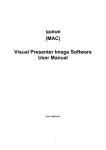
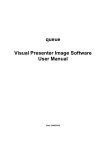
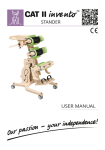
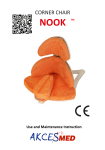
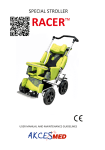

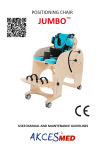





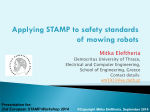
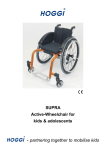
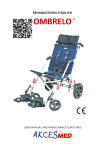
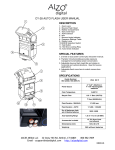
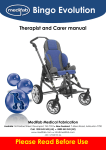
![ACTIVALL - Instrukcja Obsługi_EN [w5] - Akces](http://vs1.manualzilla.com/store/data/005768844_1-d053a11c07508a5544c783645c43d650-150x150.png)



